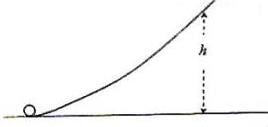Test: Physics Mock Test - 9 - NEET MCQ
30 Questions MCQ Test - Test: Physics Mock Test - 9
In a series LCR circuit, resistance R = 10 Ω and the impedance Z = 20 Ω . The phase difference between the current and the voltage is
Atomic mass number of an element is 232 and its atomic number is 90. The end product of this radioactive element is an isotope of lead. The number of alpha and beta particles emitted is
A system consists of two identical particles one particle is at rest and the other particle has an acceleration 'a'. The centre of mass of the system has an acceleration of
A small solid cylinder rolls up along a curved surface (fig.) with an initial velocity v. It will ascend up to a height ‘h’ equal to

A bullet of mass m is fired into a block of wood of mass M which hangs on the end of a pendulum and gets embedded in it. When the bullet strikes the wooden block, the pendulum starts to swing with a maximum rise R. The velocity of the bullet is given by
The electrical resistance of a mercury column in a cylindrical container is R. When the same mercury is poured into another cylindrical container twice the radius of cross-section, the resistance of mercury column now is
An electric dipole consists of two opposite charges of magnitude ± q seperated by 2a. When the dipole is placed in uniform electric field E, to have minimum potential energy, then dipole moment p makes which the following angle with E
The acceleration due to gravity at a height 1/10th of the radius of the earth above the earth's surface is 8.2 m-s⁻2. Its value at a point at the same distance below the surface of the earth is
A galvanometer having a resistance of 50 Ω gives a full scale deflection for a current of 0.05A. The length in meter of a resistance wire of area of cross section 2.97 x 10 − 3 c m 2 that can be used to convert the galvanometer into an ammeter which can be read a maximum of 5A current is [specific resistance of the wire = 5 x 10−7 c m 2 Ω − m ]
The moment of inertia of a uniform thin rod of length L and mass M about an axis passing through a point at a distance of L/3 from one of its ends and perpendicular to the rod is
The acceleration of a particle is increasing linearly with time t as bt. The particle starts from the origin with an initial velocity ν₀. the distance travelled by the particle in time t will be
A body is projected at such an angle that the horizontal range is three times the greatest height. The angle of projection is
A stone of mass 1 kg tied of the end of a 1 m long string, is whirled in a horizontal circle, with a uniform angular velocity of 2 rad-s⁻1. Tension of the string is
Two simple harmonic motions with the same frequency act on a particle at right angles i.e., along x and y-axis. If the two amplitudes are equal and the phase difference is π/2, the resultant motion will be
Range of a projectile is R, when the angle of projection is 30o. Then, the value of the other angle of projection for the same range is














